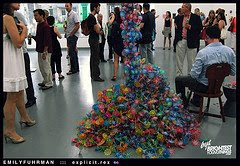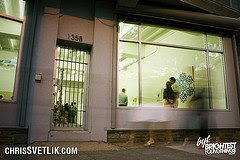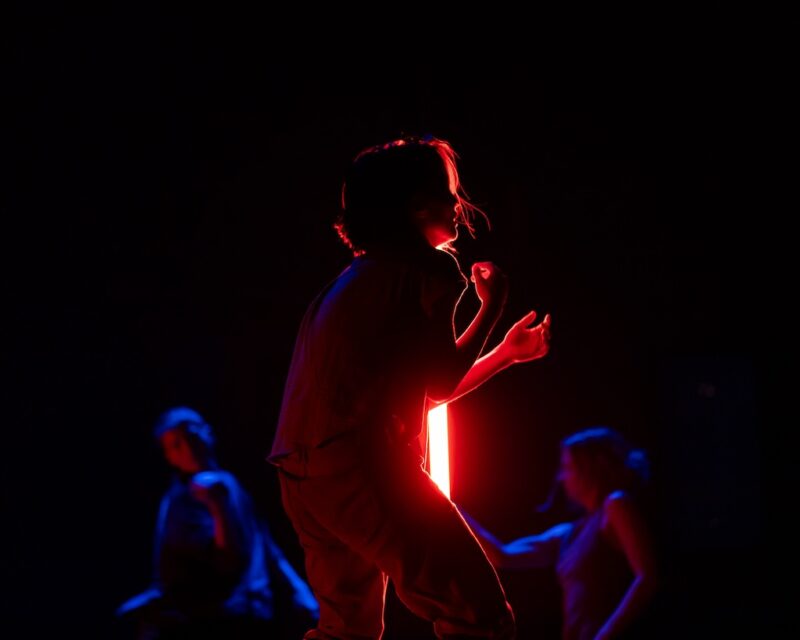 MICA alumnus Danny Baskin ’09 is one of two artists exhibiting in Conner Contemporary Art’s Academy 2009 show to win a PULSE Presents award. PULSE Contemporary Art Fair awarded Baskin with exhibition space at PULSE Miami 2009, which takes place in December.
MICA alumnus Danny Baskin ’09 is one of two artists exhibiting in Conner Contemporary Art’s Academy 2009 show to win a PULSE Presents award. PULSE Contemporary Art Fair awarded Baskin with exhibition space at PULSE Miami 2009, which takes place in December.
Full disclosure: Danny was a student in my professional practices class at MICA and I think he is terrific. Photos of Danny’s work are courtesy of his website, the brightest young things site, and mica.
Cara Ober: When did you graduate from MICA and what did you study there? What are the most important things you learned at MICA?
Danny Baskin: I graduated with the class of 2009 in the spring, only a few short months ago. I was a GFA major for the last two years. I began as an Illustration major, though. I learned a lot of different things while at MICA and living in Bmore. One important thing a teacher passed on to me is that, “things don’t fall wrong.” Kenneth Martin, a magnificent sculpture professor, taught me that. I believe he meant that different materials do what they are meant to do. There is a natural order of how objects and materials work and grow and break and fall.
We can either work against that, and try to make a material do something it doesn’t want to do, or we can work with it and let the material act as the material will. Either way, we must be conscious of how that material falls, of how that object works, and how we must work with it, or work against it.
CO: After your recent graduation, what are your plans?
DB: My plans after graduation are to move to New Orleans, LA and work there for a while to raise funds for a record store a friend and I plan on starting. I also plan on actively joining the wonderful art community that’s there. Basically, I’m gonna move to NOLA and see what opportunities arise. CO: How were you selected for the Academy show? This is the ninth annual invitational survey of outstanding work by recent fine art graduates of regional college art programs (both graduate and undergraduate) that Conner Contemporary gallery in DC has sponsored. Who did you work with there and how was the experience, in terms of professionalism, organization, etc.?
CO: How were you selected for the Academy show? This is the ninth annual invitational survey of outstanding work by recent fine art graduates of regional college art programs (both graduate and undergraduate) that Conner Contemporary gallery in DC has sponsored. Who did you work with there and how was the experience, in terms of professionalism, organization, etc.?
 DB: The Academy show at Conner was a big surprise to me. I remember at my senior thesis show, I was perched in front of my work doing a performance. Throughout the night, people would come up and chat with me about this or that. One of those people happened to be Leigh Conner, the Director of Conner Contemporary in DC. About a month or two before the show, Jamie Smith, the Chief Curator at the gallery, contacted me. She invited me to be a part of Academy 2009 and obviously I said, “Yes!” Jamie and I emailed back and forth about all the details of the show including what pieces I should include, how high the ceilings are, and other assorted things. In time, the Assistant Director, Faith Flanagan, contacted me with paperwork details and other things needed for press releases.
DB: The Academy show at Conner was a big surprise to me. I remember at my senior thesis show, I was perched in front of my work doing a performance. Throughout the night, people would come up and chat with me about this or that. One of those people happened to be Leigh Conner, the Director of Conner Contemporary in DC. About a month or two before the show, Jamie Smith, the Chief Curator at the gallery, contacted me. She invited me to be a part of Academy 2009 and obviously I said, “Yes!” Jamie and I emailed back and forth about all the details of the show including what pieces I should include, how high the ceilings are, and other assorted things. In time, the Assistant Director, Faith Flanagan, contacted me with paperwork details and other things needed for press releases.
 They all helped me tremendously in figuring out how to go about my first real show. When I actually arrived in DC a few days before the show to begin setting everything up and installing the work, they were very helpful and answered any questions I had. I didn’t feel the cold pretentiousness that many ascribe to the art world. It was my first real dealings with gallery owners and curators and they were extremely pleasant and helpful the entire way through. The show itself was a good time for the most part. There was free booze, a bunch of folks asking me questions (which I was more than happy to answer), and an after party.
They all helped me tremendously in figuring out how to go about my first real show. When I actually arrived in DC a few days before the show to begin setting everything up and installing the work, they were very helpful and answered any questions I had. I didn’t feel the cold pretentiousness that many ascribe to the art world. It was my first real dealings with gallery owners and curators and they were extremely pleasant and helpful the entire way through. The show itself was a good time for the most part. There was free booze, a bunch of folks asking me questions (which I was more than happy to answer), and an after party.
CO: This year, as part of Conner Contemporary’s Academy Show one artist was awarded a solo show at Pulse contemporary international art fair in Miami in December 09. Several jurors were brought in to choose and you were one of two emerging artists chosen for this award. How does this exhibition work? How are you feeling about the opportunity?
DB: There were two winners this year for the PULSE Miami show; myself and another young fella who made beautiful steel sculptures that hung in the outdoor space of the gallery – Andrew Schrock. He and I will both be exhibiting in Miami.
 Honestly, I have no idea how the exhibition in Miami works. It sounds like a great opportunity so I will be there with bells on, but all I know about the Art Fair is what I could find on the Internet. The evening of the Academy show, when I was announced as one of the artists to participate in Pulse Miami, I spoke to Ed Winkleman (a gallery owner in New York) and Helen Allen (Exec. Director of Pulse) about the Miami show in very broad terms. They both said that they would, “be in touch” which made me feel very professional. In the coming weeks, I will hear from them and figure out more about the Fair and what I have to do to prepare. For the time being, I’m brainstorming what I can or should show and how easy it will be to transport.
Honestly, I have no idea how the exhibition in Miami works. It sounds like a great opportunity so I will be there with bells on, but all I know about the Art Fair is what I could find on the Internet. The evening of the Academy show, when I was announced as one of the artists to participate in Pulse Miami, I spoke to Ed Winkleman (a gallery owner in New York) and Helen Allen (Exec. Director of Pulse) about the Miami show in very broad terms. They both said that they would, “be in touch” which made me feel very professional. In the coming weeks, I will hear from them and figure out more about the Fair and what I have to do to prepare. For the time being, I’m brainstorming what I can or should show and how easy it will be to transport.
 CO: Please describe the work you exhibited at the Academy show. What media did you use? What is your work about?
CO: Please describe the work you exhibited at the Academy show. What media did you use? What is your work about?

DB: I showed three pieces at the Conner show; ‘Pigs Feet’ which is a group of paraffin wax molds of pig’s feet, “Guns” which is a small suitcase filled with images of guns cut from magazines, and an untitled piece in which I opened thousands of toothpick parasols (otherwise known as cocktail umbrellas) and dropped them into a large pile that accumulated into a column of umbrellas raising to the ceiling. All these pieces are dealing with specific objects and the multiple. They are all different objects so I have to go about the pieces in different manners yet they all have an action that goes along with them.
 The process of making these things is very important to me. The cutting of paper is a very arduous task and one learns a lot about the kind of paper magazines are printed upon by simply cutting for hours and hours on end. I learned an extreme amount of the different angles and functions of firearms by just staring at pictures of them for days and days. This was a task of endurance, but it was more so a focus on the action of cutting and the different actions people must go through to use these guns. In the end I leave them in a suitcase, waiting to be found by the proper authorities. The Pig’s Feet are different in that the action is not as demanding, but I become aware of the smell, shape, and weight of the object just as well. With this piece, I am glorifying an otherwise disgusting or unloved object. As feet and pigs separately have bad reputations, the foot of a pig has a lot of bad connotations that go with it. By making such an object translucent, romantic, and subtly aromatic, I try to change the thoughts that are conjured by this object. Also, multiplying this task and caring for each reproduction is to say that more than just one individual needs this.
The process of making these things is very important to me. The cutting of paper is a very arduous task and one learns a lot about the kind of paper magazines are printed upon by simply cutting for hours and hours on end. I learned an extreme amount of the different angles and functions of firearms by just staring at pictures of them for days and days. This was a task of endurance, but it was more so a focus on the action of cutting and the different actions people must go through to use these guns. In the end I leave them in a suitcase, waiting to be found by the proper authorities. The Pig’s Feet are different in that the action is not as demanding, but I become aware of the smell, shape, and weight of the object just as well. With this piece, I am glorifying an otherwise disgusting or unloved object. As feet and pigs separately have bad reputations, the foot of a pig has a lot of bad connotations that go with it. By making such an object translucent, romantic, and subtly aromatic, I try to change the thoughts that are conjured by this object. Also, multiplying this task and caring for each reproduction is to say that more than just one individual needs this.
The ‘Umbrella Vine’ as many people call it is mainly about the action that goes with the object. There is no other object that uses the same actions one uses to open toothpick parasols. This ridiculous object with its utter uselessness comes with an action that is just as useless as the object itself. I put myself up to the task of learning this object and the action that goes with it inside and out, caring and obsessing over the task before me. As an art object or a souvenir of the actual art of opening, I leave a vine and a pile. The small pieces come together as one mass unit, showing the beauty and strength of repetition. These small, delicate items seem puny when looked upon singularly. When amassed into a pile of sharp points and colorful patterns, one fears falling over into them. The column of parasols is solid, one singular item, and no longer a number of smaller pieces but now a new, distinct object.
 CO: Your newest work appears to be a blend between performance and sculpture. How did you arrive at the idea of performance as art, coming from a background in illustration? You mentioned earlier the idea of letting materials ‘fall’ as they naturally do. What concepts are your works able to express because of the combination of materials, action, and repetition? What do you think is particularly contemporary about the work you are creating?
CO: Your newest work appears to be a blend between performance and sculpture. How did you arrive at the idea of performance as art, coming from a background in illustration? You mentioned earlier the idea of letting materials ‘fall’ as they naturally do. What concepts are your works able to express because of the combination of materials, action, and repetition? What do you think is particularly contemporary about the work you are creating?
 DB: The reason I loved illustration was mainly because I loved to draw. With Illustration, I could get away with realism, cartoons, or stranger more surreal images. I loved the range I could get away with. I began to stray from drawing my illustrations and started to make 3D illustrations, which were more challenging, and interesting for me. From there, I realized the restrictions of working with a client or a buying audience. I had things to say about objects. I had things to say about art, and being an illustrator wouldn’t let me do that.
DB: The reason I loved illustration was mainly because I loved to draw. With Illustration, I could get away with realism, cartoons, or stranger more surreal images. I loved the range I could get away with. I began to stray from drawing my illustrations and started to make 3D illustrations, which were more challenging, and interesting for me. From there, I realized the restrictions of working with a client or a buying audience. I had things to say about objects. I had things to say about art, and being an illustrator wouldn’t let me do that.
 The performance of my work is a fairly new concept to me. I feel the real art is the action itself in a lot of my work so why not show this to the audience instead of just a glimpse of what was done. I can do these repeated actions in front of people so they can learn and see the intricacies of the objects with me. But I take each piece separately, and perhaps my next work won’t require a performance. Perhaps the art of action will show without me in front of the piece. I am more and more interested in the idea of an “Art Object”; the act of creating being the art, the thing left from creation being the art object. The ideas I am working with are not new. Perhaps I am looking at them in my own way and constructing my own answers to my own questions, but many people in the past have contemplated the same ideas of object/art and repetition and reproduction; Warhol, Duchamp, & Manzoni coming to mind initially. Ken Tisa, a former teacher of mine, liked to say I had, “A number of mothers and fathers” in the world of art.
The performance of my work is a fairly new concept to me. I feel the real art is the action itself in a lot of my work so why not show this to the audience instead of just a glimpse of what was done. I can do these repeated actions in front of people so they can learn and see the intricacies of the objects with me. But I take each piece separately, and perhaps my next work won’t require a performance. Perhaps the art of action will show without me in front of the piece. I am more and more interested in the idea of an “Art Object”; the act of creating being the art, the thing left from creation being the art object. The ideas I am working with are not new. Perhaps I am looking at them in my own way and constructing my own answers to my own questions, but many people in the past have contemplated the same ideas of object/art and repetition and reproduction; Warhol, Duchamp, & Manzoni coming to mind initially. Ken Tisa, a former teacher of mine, liked to say I had, “A number of mothers and fathers” in the world of art.





